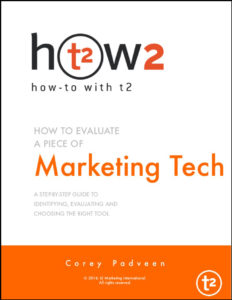The 2 Biggest Mistakes Made when Selecting Marketing Technologies
This article originally appeared on CoreyPadveen.com.
Marketers seem to fall into some pretty common traps when it comes to selecting marketing technologies to add to the arsenal.
I’ve written about the expansive market that exists in the world of marketing tech. There are thousands of tools out there (over 220 in the social media management space alone!) and it can often seem like an impossible task to select the right one for your objectives. That is due largely to the fact that some companies do a great job of selling form over substance and we simply eat it up. After all, a good salesperson will make just about anything appealing. But when it comes to selecting marketing technologies, there are some mistakes that are much more common, and costly, than others.

Among those mistakes are the two cited here. Now, I am by no stretch saying that these are the only missteps a marketer might make, and I am not saying that by being cognizant of these mistakes you’ll be able to remedy the errors of choosing the wrong tool, but your awareness and avoidance of these two issues will certainly help make the process simpler, and can certainly lead to greater results.
Tools that Don’t Play Nice
Like I said, a good salesperson will make the product they’ve been hired to sell look and sound like the perfect solution. While, on the surface, a tool might seem to solve an issue, one thing that marketers often forget is that for a product to really work, it’s going to need to do more than that. It needs to fit.
I can’t tell you how many times I’ve worked with products that are built to operate in a vacuum. In some cases, it can be even worse; a lot of products (particularly those that are part of a larger cloud) are designed (or, after an acquisition, redesigned) to work optimally with the cloud as a whole, and integrations with other technologies (or functionality that makes them much friendlier) are removed. Marketers need to look past the superficial capabilities and see how a product might work with other tools and processes that already exist.
Let’s think about this issue in the context of a business intelligence application.
Business intelligence dashboards can be very impressive. They become even more impressive as you are walked through a demo account and see the full range of capabilities that exist when the tool is used to its full potential. But what if you decide to invest in the dashboard only to find that it does not integrate fully with your CRM, or that it integrates, but there are breakages in the structure that lead to difficulties when trying to analyze your data (mechanically). Then, your workload actually increases as opposed to lightening as a result of your new tool.
Take some time and make sure that whatever you plan to add to your toolbox works well with everything else that you are currently using.
Investments are Not One-Dimensional
Another major mistake that marketers make when it comes to selecting marketing technologies has to do with the wonderful world of economics.
When it comes to price, there is a broad spectrum into which these tools fall. There is everything from a set of free applications to the kind of products that only the Fortune 100’s of the world can afford. But we’re not talking about a financial investment in this case – we’re talking about investments of your time. Marketers need to think about the human capital investment that needs to be made in order to capitalize on the use of a product.
Technologies, while impressive, are not foolproof or completely automated yet. There are still several hours (and in some cases much more) of training and implementation that need to be considered. There are even products out there that might require a new, fully-trained staff member using it on a full-time basis in order to reap all the benefits the product offers. We tend to forget about those costs. When we dive into a piece of technology without recognizing the time it will take to learn everything there is to know and leverage its applications to the fullest, our investment into the license turns into a sunk cost. That sunk cost is then increased significantly when we consider the man-hours that went into using the tool (with no results).
You’ll want to do your due diligence (generally by referring to reviews and write-ups that are not influenced by the tech company itself) to see if you can afford to invest the time it will take to master a product. And don’t be fooled by the marketing message that every product is designed to be used to the fullest in just a few minutes; even the technologies that have built their reputation on simplicity and user-friendliness will take at least a small investment of time. We need to factor that into a buying decision as well.
Conclusion
Again, these are not the only issues that marketers face when it comes to selecting a new technology, but they are two of the more costly ones. If you can wrap your head around these two issues, then the chances of selecting the right product increases dramatically. If you want to know more about the process of selecting the right piece of marketing technology, I suggest downloading the new How 2 with t2 eBook. In it, we cover the steps marketers need to take in order to ensure that the investment is right and the benefits are reaped in their entirety.





